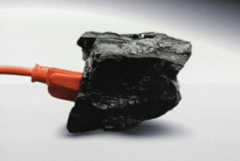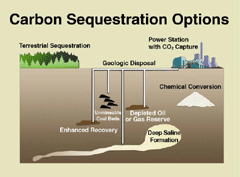Coal's Carbon Capture in Question
Air Date: Week of February 8, 2008

(Photo: America's Power)
The coal industry says it can trap its global warming gases and put them back in the ground where they came from - a process called carbon capture and storage. But the federal government just pulled the plug on the biggest carbon capture project, Futuregen. Living on Earth's Jeff Young reports on the big questions about carbon capture and coal's future.
Transcript
GELLERMAN: From the Jennifer and Ted Stanley Studios in Somerville, Massachusetts—this is Living on Earth. I’m Bruce Gellerman, in for Steve Curwood.
Half of the country’s electricity comes from burning coal. But along with the energy, coal pumps a lot of greenhouse gases into the atmosphere, contributing to global warming. The coal industry says it can meet the challenge of climate change with technology called carbon capture and storage—basically, grabbing the CO2 and putting it back where it came from: in the ground.
Maybe you caught this TV ad by the coal industry:
VOICEOVER: We’re committed to a future in which our most abundant fuel—coal—generates our electricity with even lower emissions, including the capture and storage of CO2.

Carbon storage, or sequestration, essentially puts the CO2 back in the ground where it came from, so it does not become a greenhouse gas in the atmosphere. It can work, but the massive volume of CO2 in question presents great challenges. (Courtesy of the Department of Energy)
And as Living on Earth’s Jeff Young reports, that raises questions about the future of coal.
YOUNG: You know that a once obscure energy technology has become pretty important when it becomes an applause line in the president’s State of the Union address.
BUSH: Let us fund new technologies that can generate coal power while capturing carbon emissions. (Applause)
YOUNG: That applause came from both sides of the partisan aisle. Nearly everyone in Washington with a plan for climate change is banking on carbon capture and storage, also known as sequestration, to play a big role. Energy secretary Sam Bodman says it’s crucial to the future of coal.
BODMAN: The heart and soul of using coal, which we are great believers in, is going to be using carbon capture and sequestration, and that’s exactly what we are trying to accomplish.

The zero-emissions coal power plant envisioned by the FutureGen Alliance looked good on paper, but ballooning costs caused the government to scrap these plans. (Photo: FutureGen Alliance)
HOVORKA: Sequestration is absolutely doable. If I got so say one thing to people out there it would be that if you want power that reduces your guilt of releasing CO2 into the atmosphere, you can have it. The question is, do people want it? Because it's not free.
YOUNG: And the price is taking a toll on the biggest carbon capture project yet proposed. For the past four years the centerpiece of that research by both the government and the private sector has been FutureGen.
MUDD: FutureGen is further ahead than any other such plant in the world.
YOUNG: That’s Mike Mudd with the FutureGen Alliance. Two dozen of the world’s biggest producers and users of coal joined with the Department of Energy to plan the first zero emissions coal power plant. After three years of study, the alliance met in December to announce where the plant would be built.
MUDD: So now the moment we’ve been waiting for: the alliance intends to select Mattoon, Illinois, to host the FutureGen project. (smattering of applause)

The coal power industry says it can cut carbon dioxide emissions from coal. But the government just pulled the plug on the industry's leading carbon capture project. (Photo: America's Power)
BODMAN: I felt it didn’t make sense to go forward. It was at that point in time that I blew the whistle on the project.
YOUNG: Bodman insists he’s not scrapping the project, but rather restructuring it to clarify its purpose and get industry to pay a greater share of the cost. Those private sector partners were disappointed. FutureGen alliance member Paul Thompson, with the energy utility company E-ON, says it will be much harder for his industry to learn how to apply carbon capture on a commercial
scale.
THOMPSON: If you don’t have a FutureGen I think you’re just gonna delay the time frame for getting the answers that we need.
YOUNG: It’s not yet clear if the companies involved will continue with the restructured project. On capitol hill, anxious coal-state senators, like Wyoming’s John Barrasso and John Tester of Montana, let Bodman know they were not happy.
BARRASSO: And with this change with FutureGen I think that confidence is eroding.
TESTER: I echo Senator Barrasso’s comments. We have to have the technology.
YOUNG: The most optimistic target for a FutureGen startup is now 2015—four years later than originally planned. Energy experts say it raises real doubts about the promise of carbon capture
as a climate solution.
ROMM: I don’t think it’s a good sign that the government and industry could not get their act together, figure out what this project was supposed to be and then do it, given how important it is for the future of their country and the planet.
YOUNG: Joseph Romm served in the energy department during the Clinton administration. Now he’s a fellow at the Washington think tank, Center for American Progress. Romm says the sheer volume of CO2 from coal presents more hurdles. Simply moving it around would require miles of new pipelines. A large release could prove fatal and there are risks to underground water supplies. The Environmental Protection Agency says it will take another three years just to write regulations on that. Romm thinks it all means carbon capture will be much more difficult than many of its proponents would like.
ROMM: People’s conception of how much it can deliver is probably wildly overrated. So I’m hopeful that carbon capture and storage could be part of the solution, but I think people need to understand it is certainly no silver bullet and one just has to put a big question mark on it.
YOUNG: And with FutureGen pushed even further into the future, the promise of more climate-friendly coal power is up in the air. For Living on Earth, I’m Jeff Young in Washington.
Links
Living on Earth wants to hear from you!
Living on Earth
62 Calef Highway, Suite 212
Lee, NH 03861
Telephone: 617-287-4121
E-mail: comments@loe.org
Newsletter [Click here]
Donate to Living on Earth!
Living on Earth is an independent media program and relies entirely on contributions from listeners and institutions supporting public service. Please donate now to preserve an independent environmental voice.
NewsletterLiving on Earth offers a weekly delivery of the show's rundown to your mailbox. Sign up for our newsletter today!
 Sailors For The Sea: Be the change you want to sea.
Sailors For The Sea: Be the change you want to sea.
 The Grantham Foundation for the Protection of the Environment: Committed to protecting and improving the health of the global environment.
The Grantham Foundation for the Protection of the Environment: Committed to protecting and improving the health of the global environment.
 Contribute to Living on Earth and receive, as our gift to you, an archival print of one of Mark Seth Lender's extraordinary wildlife photographs. Follow the link to see Mark's current collection of photographs.
Contribute to Living on Earth and receive, as our gift to you, an archival print of one of Mark Seth Lender's extraordinary wildlife photographs. Follow the link to see Mark's current collection of photographs.
 Buy a signed copy of Mark Seth Lender's book Smeagull the Seagull & support Living on Earth
Buy a signed copy of Mark Seth Lender's book Smeagull the Seagull & support Living on Earth

